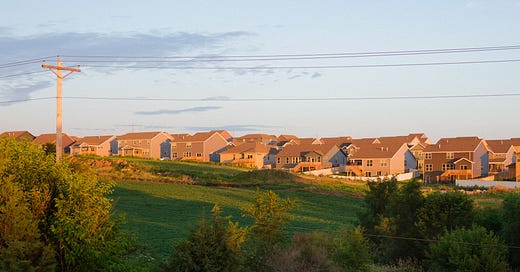The Democrats have a plan…sort of. In the face of a dreadful political environment dominated by voters’ negative judgment on Democrats’ economic stewardship and further defined by strong disapproval of Democrats’ approach on issues like crime and immigration, Democrats propose to flip the script by focusing their message on abortion and guns. Here they feel they are on stronger ground and can win the all-important battle for the suburbs.
The idea seems to be that the suburbs are full of liberal, highly-educated voters who are likely to be particularly moved by these issues and turn out against the Republicans. That may be true in some limited areas at the margins but it seems highly unlikely to work in the suburbs writ large for a very simple reason: actually-existing suburban voters are quite different from this caricature.
Start with who actually lives in the suburbs. Contrary to popular perception, less than a third of the suburban vote nationwide is made up of college-educated whites, the presumed locus of appeal for the suburban abortion/guns/very liberal on social issues vote. In fact, about three-fifths of suburban white voters are working class (noncollege).
It is widely misunderstood how vital these voters were to Biden’s victory in 2020. While suburban white college voters shifted around 10 margin points toward Biden, suburban white working class voters also had a solid 5 point pro-Democratic shift. Because of this group’s larger size, their shift toward Biden contributed almost as much to the Democrats’ improved margin over Trump in 2020 as suburban white college voters.
And just how liberal are these college-educated voters anyway? Overall, according to Gallup, just 30 percent of adults with a four year degree only describe themselves as liberal and 36 percent of those with some postgraduate education (the less numerous group) do so. Putting this together with the data about suburban demographics, this implies that perhaps one-ninth (a third of a third) of suburban voters are white college-educated liberals. Perhaps the figure is a bit higher but I doubt that it’s much higher.
Looking at some states that will have high profile races, we see a similar story. In Pennsylvania, where the Democrats are seeking to wrest a Senate seat from the Republicans, suburban voters are either around urban cores in large metro areas (Philly, Pittsburgh, Allentown, Harrisburg, Scranton) or in small metro areas (Erie, Reading, Lancaster, York, etc). According to analysis by William Frey of Brookings, the former areas are 58 percent white noncollege to 29 percent white college, while the latter areas are 64 percent white working class to 23 percent white college.
In Wisconsin, another state where Democrats are seeking to capture a Republican-held Senate seat to balance possible losses by Democratic incumbents, the situation is no different. Suburbs around Milwaukee and Madison are 53 percent white working class to 37 percent white college while Wisconsin’s smaller metro areas (Oshkosh, Green Bay, Appleton, etc) are 65 percent white noncollege to 25 percent white college.
And in Georgia, where Democrat Raphael Warnock hopes to hold onto his Senate seat against Republican (and football legend) Herschel Walker, the Atlanta and Augusta suburbs are 49 percent white working class to just 19 percent white college, while the small metro areas (Savannah, Macon, etc.) are 42 percent white noncollege to 18 percent white college. The large proportions of black and secondarily Hispanic voters in these suburbs, who we know to be generally less liberal than white college graduates, seem more likely to be concerned with the very economic issues that are dragging the Democrats down than to be galvanized by gun control and abortion rights.
Finally, an issue like abortion rights is vexed for the Democrats by the complications of public opinion on the issue, including in the suburbs. It is undeniably true that suburban voters are opposed to the overturning of Roe v. Wade but it is also true that they are open to significant limits on access to abortion—for example, suburban voters, by 53 percent to 41 percent, say they would favor a law in their state confining access to abortion (except in the case of medical emergency) to the first 15 weeks of a pregnancy. This suggests a contested playing field where Democrats’ ability to mobilize voters around the issue may be hindered by the party’s commitment to more or less unfettered access, which is not particularly popular.
In sum, the Democrats’ plan to turn the election around by targeting suburban voters on abortion rights and gun control seems mathematically challenged and unlikely to work in the current environment. Once again, the Democrats may be basing their strategy around an electorate that they wish existed but does not in the real world. Perhaps after November they will reconsider this approach.




